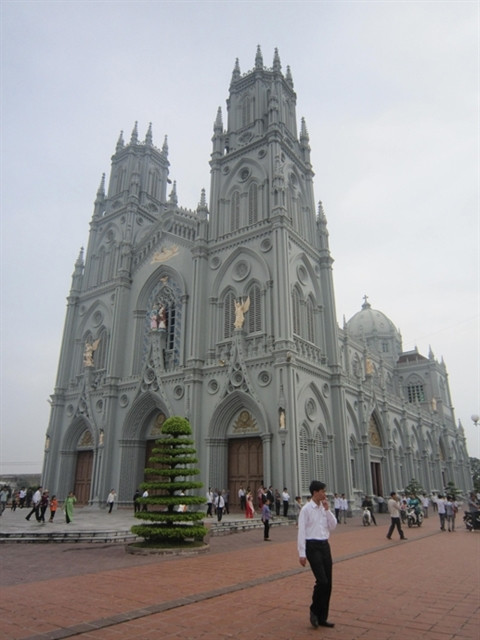 Kien Lao Church, which was built in 1533, is one of the most beautiful catholic churches in Nam Dinh province. (Photo: nhathoconggiao.com)
Kien Lao Church, which was built in 1533, is one of the most beautiful catholic churches in Nam Dinh province. (Photo: nhathoconggiao.com)Nam Dinh (VNS/VNA) - The ancient Catholic villageof Kien Lao in northern Nam Dinh province is well known forits bronze casting.
Nowadays, italso produces machinery for construction projects across thecountry.
Mai Van Tan, from Xuan Tien village, said: “Bellcasting has been around for more than 200 years, and there is still roomto develop.”
Village elder Le Van Hao said thecraft was founded by Le Van Nghiem, who took the art of casting thefamous Dong Son bronze drums in Thanh Hoa to Kien Lao.
The last six generations of the Le Van clan havecontinued his work and provided stable jobs for local people.
From the youngest generation, Le Van Kha saidhis workshop produces bells and statues weighing from 0.5-7 tonnes.
“I was born into a bronze casting family, so Iknow how to fire up the furnace and combine the right ratio of bronzeand tin, as well as designing patterns on items such as bells,” Kha said.
To make a bronze bell, a worker first has tomake a mould from clay mixed with rice husks. The mould is then fired toharden it, and while it cools workers design patterns inside before firing itagain, he said.
The most important part of the process is thebronze casting itself. Only skilled workers know when the molten metal isready to pour it in the mould, Kha said.
“We have to work carefully through each stage toensure quality,” he said.
Thanks to this meticulousprocess, customers from across the country order his items. Ha Tinhordered a 5-tonne bell to place at the Dong Loc crossroads, while theSpratly Islands commissioned a 7-tonne bell to hang on the archipelago.
Kha’s younger brother, Le Van Khiem, is anexpert in casting bronze statues.
“Kien Lao casts are always high qualitythanks to the dedicated workers. The process of polishing the statuesis very important to ensure their longevity," Khiem said.
“I still need to improve my skills andaccumulate experience every day. That's my secret,” he said.
Painter Tran Hoang from Hanoi said: “Peoplecan see the soul in Khiem’s statues of President Ho Chi Minh and village gods,particularly in his Buddha statues that can be found in many pagodas across thecountry.”
To cast a statue, a worker needs skilled handsand a rich imagination, and more importantly they need to know the correctsize, physical form, costumes and characteristics of each statue.
Hoang said he was impressed with Khiem’s Buddhastatues because of their expressions of mercy, leniency andsublimity.
Khiem said in most villages, thetraditional job is handed down to male heirs, but in Kien Lao, both men andwomen pursue the job.
Mai Van Hau from the Le Van clan says hisworkshop have created stable jobs for a dozen workers with monthlysalaries of 6-10 million VND per person.
“We produce different kinds of bells; some forchurches and others for pagodas. Each bell has its own sound. The church bellshave a higher pitch while pagoda bell emits a lower tone,” Hau said.
A perfect bell should ensure the right tone,shape and designs, he said.
Hau’s fame has spread far and wide. He hasreceived orders to cast Buddha statues for pagodas and temples throughout thecountry, including Vang Pagoda in Tam Dao and Thien Son Pagoda in Vinh Phucprovince, and a statue of national hero Tran Hung Dao for Thang PhucPagoda in Hai Phong.
His workshop also cast a bell for ThangLong Citadel for the 1,000th anniversary of the capital city ofHanoi. The bell hangs in Kinh Thien Palace inside the Citadel.
Hau’s three younger brothers all have their ownworkshops.
One of them, Mai Van Phuong, said: “We areCatholic but we know about Buddha and other religions. We do a lot of researchfor our work.”
“Even though we are busy with new orders,we are preparing to welcome Christmas by decorating our homes and buying newclothes for the festive church service.”/.






























